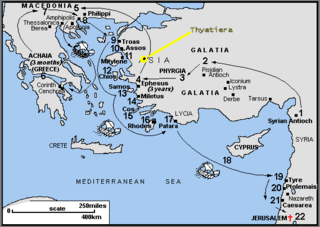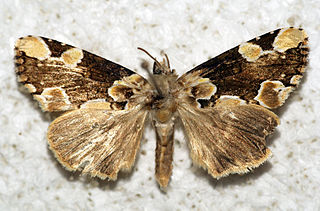
Thyateira was the name of an ancient Greek city in Asia Minor, now the modern Turkish city of Akhisar. The name is probably Lydian. It lies in the far west of Turkey, south of Istanbul and almost due east of Athens. It is about 50 miles (80 km) from the Aegean Sea.

The peach blossom is a moth of the family Drepanidae. It was first described by Carl Linnaeus in his 1758 10th edition of Systema Naturae.
The Battle of Thyatira was fought in 366 at Thyatira, Lydia, between the army of the Roman Emperor Valens and the army of the usurper Procopius, led by his general Gomoarius.

Lydia of Thyatira is a woman mentioned in the New Testament who is regarded as the first documented convert to Christianity in Europe. Several Christian denominations have designated her a saint.

The Thyatirinae, or false owlet moths, are a subfamily of the moth family Drepanidae with about 200 species described. Until recently, most classifications treated this group as a separate family called Thyatiridae.

Clytra is a genus of short-horned leaf beetles belonging to the family Chrysomelidae, subfamily Cryptocephalinae.

Thyatira is a genus of moths belonging to the subfamily Thyatirinae of the Drepanidae. It was erected by Ferdinand Ochsenheimer in 1816.
Thyatira brasiliensis is a moth in the family Drepanidae. It was described by Werny in 1966. It is found in Brazil.
Thyatira casta is a moth in the family Drepanidae. It was described by Felder in 1874. It is found in Colombia.
Thyatira cognata is a moth in the family Drepanidae. It was described by Warren in 1888. It is found in India.
Thyatira delattini is a moth in the family Drepanidae. It was described by Werny in 1966. It is found in New Guinea.
Thyatira dysimata is a moth in the family Drepanidae. It was described by West in 1932. It is found in the Philippines (Luzon).
Thyatira hedemanni is a moth in the family Drepanidae. It was described by Hugo Theodor Christoph in 1885. It is found in Georgia, Turkey, Armenia, Iran and Azerbaijan.

Thyatira mexicana is a moth in the family Drepanidae. It was described by Henry Edwards in 1884. It is found in the US state of Arizona through Central America to South America.
Thyatira philippina is a moth in the family Drepanidae. It was described by Gyula M. László, Gábor Ronkay, László Aladár Ronkay and Thomas Joseph Witt in 2007. It is found on Mindanao in the Philippines.
Thyatira staphyla is a moth in the family Drepanidae. It was described by Paul Dognin in 1890. It is found in Loja Province, Ecuador.
Thyatira tama is a moth in the family Drepanidae. It was described by Schaus in 1933. It is found in Colombia.
Thyatira vicina is a moth in the family Drepanidae. It was described by Achille Guenée in 1852. It is found on Java and Bali in Indonesia.
Dorcadion bodemeyeri is a species of beetle in the family Cerambycidae. It was described by K. Daniel in 1901. It is known from Turkey.
Phytoecia bodemeyeri is a species of beetle in the family Cerambycidae. It was described by Reitter in 1913. It is known from Iran.






